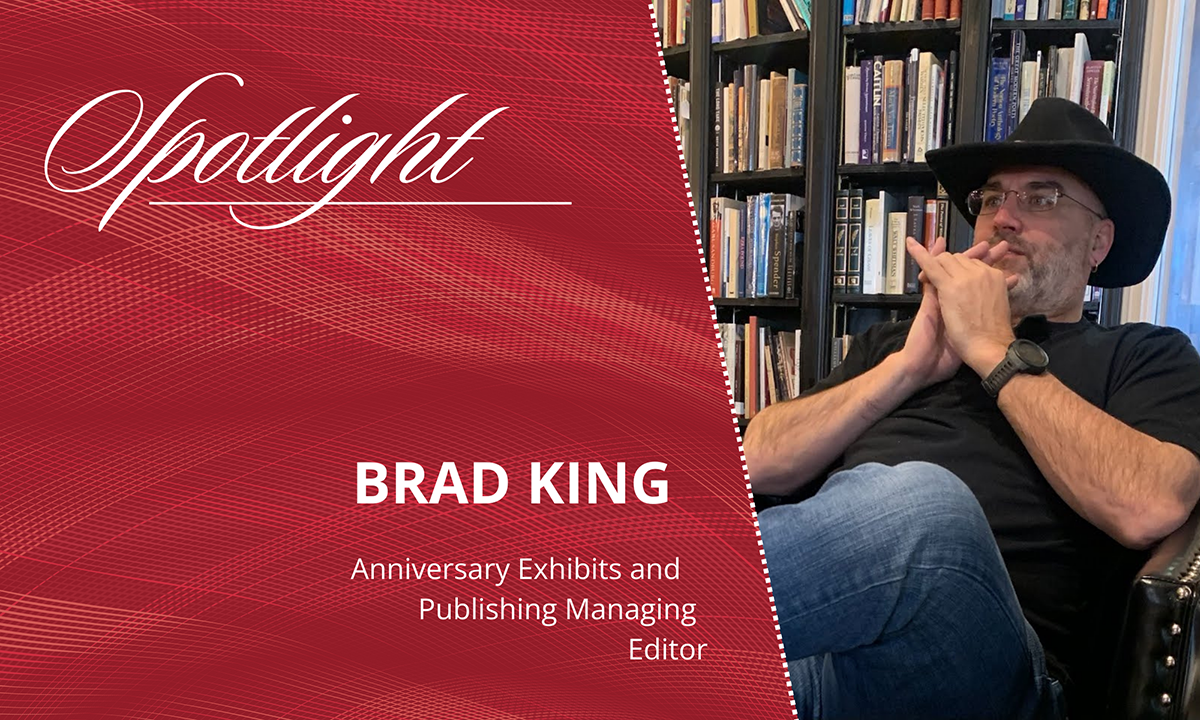
At the University Libraries, faculty and staff bring diverse backgrounds and interests to their roles, elevating the Libraries’ culture of interdisciplinary collaboration and lifelong learning and curiosity. We asked Anniversary Exhibits and Publishing Managing Editor Brad King a few questions about his work, to find out more about the inspiration behind his contributions to the campus community.
Q: In your own words, what is a quick overview of your role at the Libraries?
A: My work here in the Libraries falls into three main buckets. First, I work as the managing editor on the exhibits team with Julia Corrin and Heidi Wiren Kebe. We work on exhibits and publications related to our exhibit spaces in Hunt and the Posner Center, and we’ve been collaborating with the president’s office and other departments on exhibits around campus. Second, I work as a project manager with the exhibit team, helping coordinate our work with the various departments and groups it takes to assemble big projects. And third, I’m in charge of re-starting the oral history program, which we expect to get off the ground very soon!
Q: Talk a little about the work you’re most passionate about. Why have you chosen to pursue this work within a library setting?
A: I’ve worked as a writer, editor, and publisher for more than twenty-five years, from major publishing houses and media companies to local storytelling communities. I absolutely love telling stories and helping people get their stories out into the world. The library — specifically the Archives — is the perfect place to do that because we can connect voices from the past to the voices of today in really powerful ways.
Q: Share an experience or skillset people might not expect a librarian/library worker to have. How is it a game changer for the work you do at CMU?
A: I was an athlete when I was younger, and I’ve transitioned into coaching as I’ve gotten older. I have always loved being part of, and working with, a team. I love being part of a group where people know more than you and are better at things than you. When you harness that diversity of talent, you can do incredible things! Because of that love, I’ve spent hours learning and studying how teams work, how to remove bias from decision-making, how to work inclusively, and how to foster healthy, vibrant creative teams. The more comfortable you become working towards a common goal with people who have different skills than you, the more interesting work you can do!
Q: The Libraries serve as a neutral convening space to bring different areas of campus together. How do you value collaboration in your work? Can you give us an example of a recent collaboration that has helped a project reach new heights?
A: Honestly, every project we do with exhibits involves working with partners and collaborators with their own vision for what they want to accomplish. So, we walk into each new project with an eye on how our collective skills might enhance or bring to life what those groups want. The magic happens when we reach that “yes, and” phase of a project when we’re all building on an idea, whether figuring out how to hang massive robots in the new Robot Innovation Center or how to structure and design a publication like Dr. Jerry Cohon’s memorial book.
Q: What’s an area that you want to innovate and push boundaries in? Why is it exciting to you?
A: The most interesting place I’ve been working in an ethical, creative way with AI. I’ve trained Anthropic’s Claude on various projects using my own work and then used those specific projects as a “creative partner” in a discussion like you might with a co-author or editor. We have a staggering amount of research that goes into any exhibit. For instance, we’ve spent hundreds of hours structuring and thinking about the forthcoming World War I exhibit. I’ve trained Claude on that research and my own writing. I have used it to fact-check and source the work from my notes, I can ask it to help see patterns I might have missed, and discuss structural issues that I might not see. I don’t use it to create original work — that’s me — but it’s a fantastic tool to help me think about how to improve what I’m doing.
Q: What’s something in the Libraries that speaks to you personally? This can be a book, something in the Archives or Special Collections, a space in one of the buildings — anything you want to highlight!
A: Since childhood, libraries have always been one of my favorite places to go. I lived in a very small town growing up, and in the summer, my mom would drop me off for hours while she ran errands. I used to sit at those tables and read voraciously. I’ve carried that love with me as I went into the world. Whenever I travel, the first places I visit are the small bookstores and the libraries. No matter where I am, once I’m in the library, it feels a bit like home.
